German MK aluminum alloy thermal analyzer
Keywords: bulk grain refinement grade, modification effect, undercooling degree, aluminum alloy thermal analyzer Compiler: Liu Weihan
Foreword:
In the past, the effect of refinement and deterioration of alloys was often detected by cutting the castings and grinding metallographic samples, which was not only long in cycle, expensive, and unable to guide work on site. At present, pouring fracture samples are commonly used in production, and the effect of fine deterioration of fracture detection is observed by naked eyes. This method relies more on the experience of the operator and is not highly reliable.
status quo:
At present, the grain refinement of aluminum alloy has two directions:
●For solidification and fine-grain, the purpose of grain refinement is achieved by controlling and adjusting alloy composition, cooling rate, and external field action during solidification, including rapid solidification, mechanical field solidification, magnetic field solidification, magnetic field solidification, and electric field solidification. Crystal and ultrasonic solidification fine crystal, etc.;
●In order to modify and refine the crystal, that is, the traditional addition of nucleating agent or microalloying to achieve the purpose of refinement, including the modification and refinement of phosphorus and phosphide, the modification and refinement of sodium salt, the refinement of aluminum strontium master alloy, and the refinement of aluminum antimony master alloy Chemical/aluminum titanium boron alloy refinement and aluminum titanium carbon alloy refinement, etc.
In many foundries, thermal analysis has been successfully used to determine the degree of modification by measuring and changing the eutectic temperature.
At present, more and more foundries in the world use thermal analysis technology for rapid analysis in front of the furnace. For example, General Motors Manufacturing Co., Ford Motor Manufacturing Co., Ukraine, etc. have all adopted thermal analysis as an important method for quality control of alloys in front of the furnace.
The German MK aluminum alloy thermal analyzer TA110, which combines thermal analysis technology and microcomputer technology, can detect the effect of alloy melt grain refinement and deterioration online, reduce the cost of thermal analysis technology, and improve the reliability, accuracy and reliability of the test. Intelligent. For example, the extensive application of thermal analysis technology in casting production will surely increase the quality of my country's castings steadily and strengthen my country's competitiveness in the international casting market.
The principle of thermal analysis of aluminum alloy:
Pour the melt into the crucible, measure the temperature during the solidification process, and obtain a temperature-time curve, which is also called the cooling curve. Using thermal analysis methods, the characteristic values can be obtained from the cooling curve or its first derivative, and then the relationship between these characteristic values and some quality indicators (such as grain size, eutectic structure, silicon phase, etc.) can be established.
Thermal analysis is an ideal method to determine the structure formed during the cooling process of molten aluminum and the metallographic structure that determines the mechanical properties of the alloy and is closely related to the quality of the casting. The crystal grains formed during the solidification of the melt are mainly determined by the cooling conditions during the casting process. A finer grain structure can be obtained by selecting the correct casting process and controlling the curing conditions within the mold and pouring temperature. Another way to obtain a finer grain structure is to introduce foreign crystal nuclei into the melt in the form of suitable additives. In order to monitor the quality of the melt, thermal analysis is used to identify parameters in the cooling curve that indicate signs of the nucleation state of the melt.
The smaller the dTL value, the finer the crystal grains; the larger the dTS, the better the deterioration effect (dTL and dTS are the thermal analysis characteristic parameters automatically read by the thermal analyzer) The cooling curve is as follows:
![]()
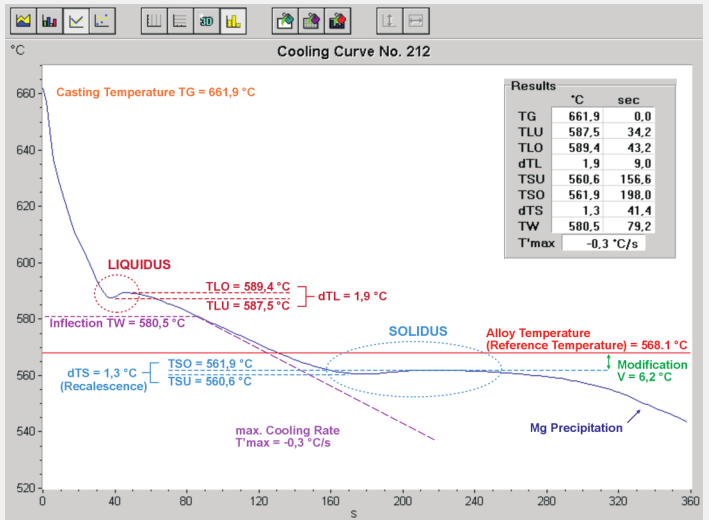
Note:
TG: detection start temperature,
TLU: lower limit of liquid phase temperature, TLO: upper limit of liquid phase temperature, dTL: solid phase subcooling,
TSU: lower limit of solid state temperature, TSO: upper limit of solid state temperature, dTS: degree of subcooling of eutectic growth,
TW: temperature inflection point, T’max: maximum cooling rate,
Alloy Temperature: Theoretical eutectic temperature, V: Correction temperature (deterioration effect).
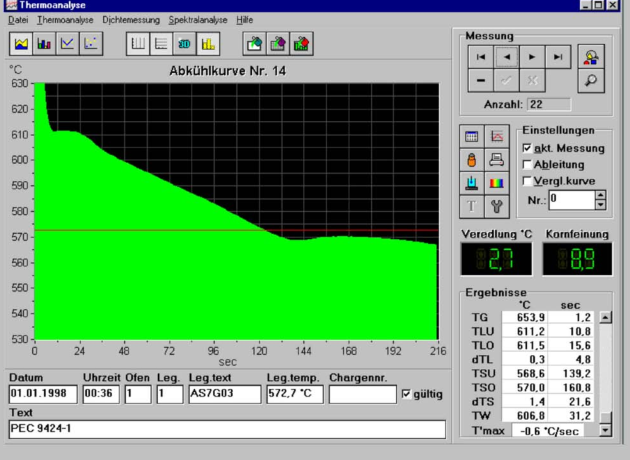
By means of thermal analysis method, it is possible to predict the modification effect of the alloy ─ ─ an important indicator of the degree of refinement of the eutectic clusters in the alloy. The determination of the degree of grain refinement (the number of eutectic clusters) during initial crystallization has become a basic factor that determines the accuracy of thermal analysis. The system can automatically determine the temperature characteristic values, such as the liquid-solid phase temperature during crystal nucleation and eutectic growth, undercooling, solidification time and casting temperature, so as to stably control the quality of castings.
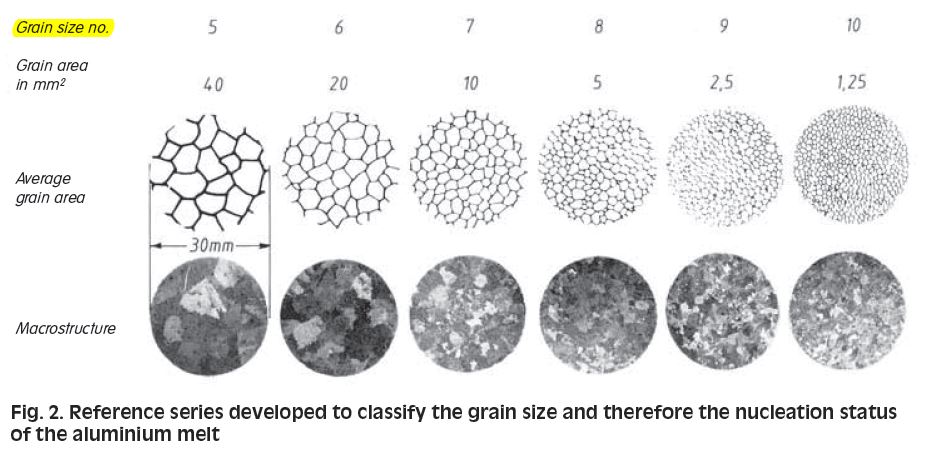
Figure 3. Shows part of the reference series. The particle size numbers 5-10 indicate medium particle size (40 to 1,25 mm2). Moreover, the intermediate stage has also been developed to confirm the accuracy of the test. In this way, the obtained grain size can be classified simply by comparing images.
The smaller the dTL value, the finer the crystal grains; the larger the dTS, the better the deterioration effect:
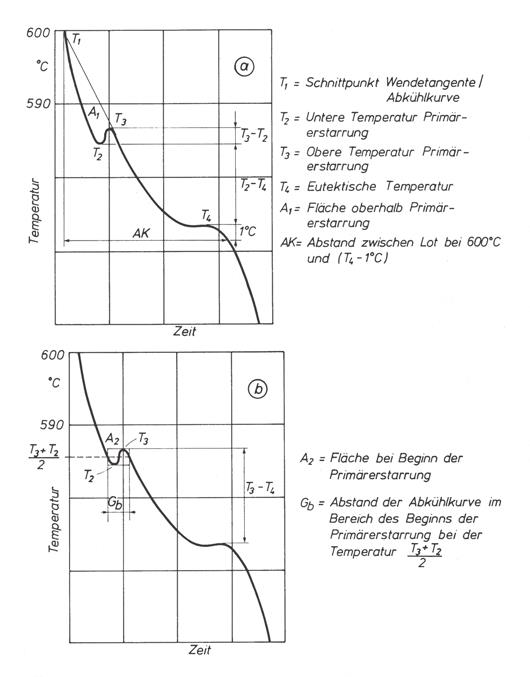
T1 = Intersection point of zigzag tangent and temperature curve
T2 = lower limit temperature of basic curing
T3 = upper limit temperature of basic curing
T4 = Eutectic temperature
A1 = higher than the basic curing area
AK = the distance at right angles between 600°C and (T4-1°C)

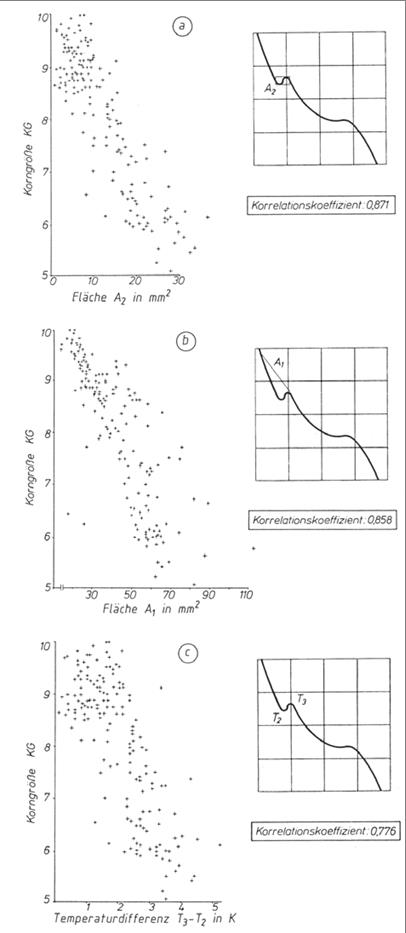
T2 = Initial curing area
Gb = The distance of the cooling curve in the initial solidification zone
- T1 Intersection point of zigzag tangent and temperature curve
- T2 Basic curing lower limit temperature
- T3 Basic curing upper limit temperature
- A1 The area higher than the basic solidification is limited by the cooling curve and the zigzag tangent
- T4 Eutectic temperature-
- Ak The distance between 600°C and the curve point (T4-1°C) at right angles
- Gb The distance between the first and last point of the intersection of the cooling curve and the temperature line (T3 + T2) / 2.
- A2 Initial curing start (T3-T2). Gb area/area
- Temperature difference:T3 - T2 = TT3-T2
T2 - T4 = TT2-T4
T3 - T4 = TT3-T4
Figure 4: The relationship between the grain size and the Gb characteristic on the cooling curve
Figure abc:
The relationship between the grain size in the cooling curve and the characteristics of A2, A1 and (T3-T2)
table1
Coefficient correlation KG | Cooling curveparameter | Suitable decision Nucleation state | |
Gb | 0,966 | 1 | |
A2 | 0,871 | 2 | |
A1 | 0,858 | 2 | |
T3 -T2 | 0,776 | 2 | |
T2 | 0,684 | 3 | |
T2 -T4 | 0,553 | 3 | |
T3 | 0,469 | 3 | |
AK | 0,465 | 3 | |
T4 | 0,449 | 3 | |
T1 | 0,412 | 3 | |
T3 -T4 | 0,238 | 3 | |
*) 1 = Suitable for, 2 = Limited applicability, 3 = Not suitable
The most suitable parameters Gb. The parameters A2, A1 and T3-T2 are suitable to a certain extent. Other quantity tests show that it has nothing to do with the nucleation of the melt.
In actual production, TA110 is used for thermal analysis of aluminum alloy. If the grain and deterioration are not up to standard, engineers can consider and adjust according to the thermal analysis data of TA110 to optimize the process: adjust the pouring temperature and the temperature of the liquid-solid phase. In addition, you can also change the amount of mass agent or other physical methods to make corrections.
to sum up:
In summary, the use of TA110 aluminum alloy thermal analyzer from Germany MK can provide scientific and accurate thermal analysis data during production. The thermal analysis data such as the grain grade and deterioration effect of aluminum alloy belong to the pre-furnace and pre-quick analysis and verification. During production, the process can be improved, monitored, and adjusted according to the thermal analysis data provided by the TA1100 aluminum alloy thermal analyzer to obtain a more ideal Crystal grains, reduce waste in production, obtain better quality castings, and improve economic benefits.
References
[1] M. J. Lessiter and W.M. Rasmussen; To pour or not to Pour The Dilemma of
Assessing your Aluminum MeltÄs Cleanliness, Moder Casting, February 1996, pp. 45-48.
[2] W. La-Orchan, Quantification of the reduced pressure test, PhD Thesis McGill
University, Montreal, Canada, 1994.
[3] D. Dispinar, Determination of the melt quality of aluminum and its alloys, PhD,
University of Birmingham, UK, January 2005.
[4] M. Di Sabatino, F. Syvertsen, L. Arnberg, and A. Nordmark, An improved
method for fluidity measurement by gravity casting of spirals in sand moulds,
International Journal of Cast Metals Research, vol.18, 59-62, 2005.
[5] K. Bangyikhan, Effects of oxide film, Fe-rich phase, Porosity and their
interactions on the tensile properties of cast AlSiMg alloys.
[6] M. B. Djurdjevic, G. Byczynski, J. Pavlovic, H. Stieler: “Quantification of the
Strontium Impact on the Solidification Path of the Al-Si-Cu Alloys Using
Thermal Analysis Technique”, Praktische Metallographie, No 49, 2009, pp.137-152.
[7] M. B. Djurdjevic, J. H. Sokolowski and H. Jiang, “On-Line Prediction of theAluminum-Silicon Eutectic Modification Level Using Thermal Analysis”,
Materials Characterization, 2000, v. 45, 31-38.



